Abstract
Carbon isotope fractionation by structurally and catalytically distinct ribulose-1,5-bisphosphate carboxylases from one eucaryotic and four procaryotic organisms has been measured under nitrogen. The average fractionation for 40 experiments was −34.1 ‰ with respect to the δ13C of the dissolved CO2 used, although average fractionations for each enzyme varied slightly: spinach carboxylase, −36.5 ‰; Hydrogenomonas eutropha, −38.7 ‰; Agmenellum quadruplicatum, −32.2 ‰; Rhodospirillum rubrum, −32.1 ‰; Rhodopseudomonas sphaeroides peak I carboxylase, −31.4 ‰; and R. sphaeroides peak II carboxylase, −28.3 ‰. The carbon isotope fractionation value was largely independent of method of enzyme preparation, purity, or reaction temperature, but in the case of spinach ribulose-1,5-bisphosphate carboxylase fractionation, changing the metal cofactor used for enzyme activation had a distinct effect on the fractionation value. The fractionation value of −36.5 ‰ with Mg2+ as activator shifted to −29.9 ‰ with Ni2+ as activator and to −41.7 ‰ with Mn2+ as activator. These dramatic metal effects on carbon isotope fractionation may be useful in examining the catalytic site of the enzyme.
Full text
PDF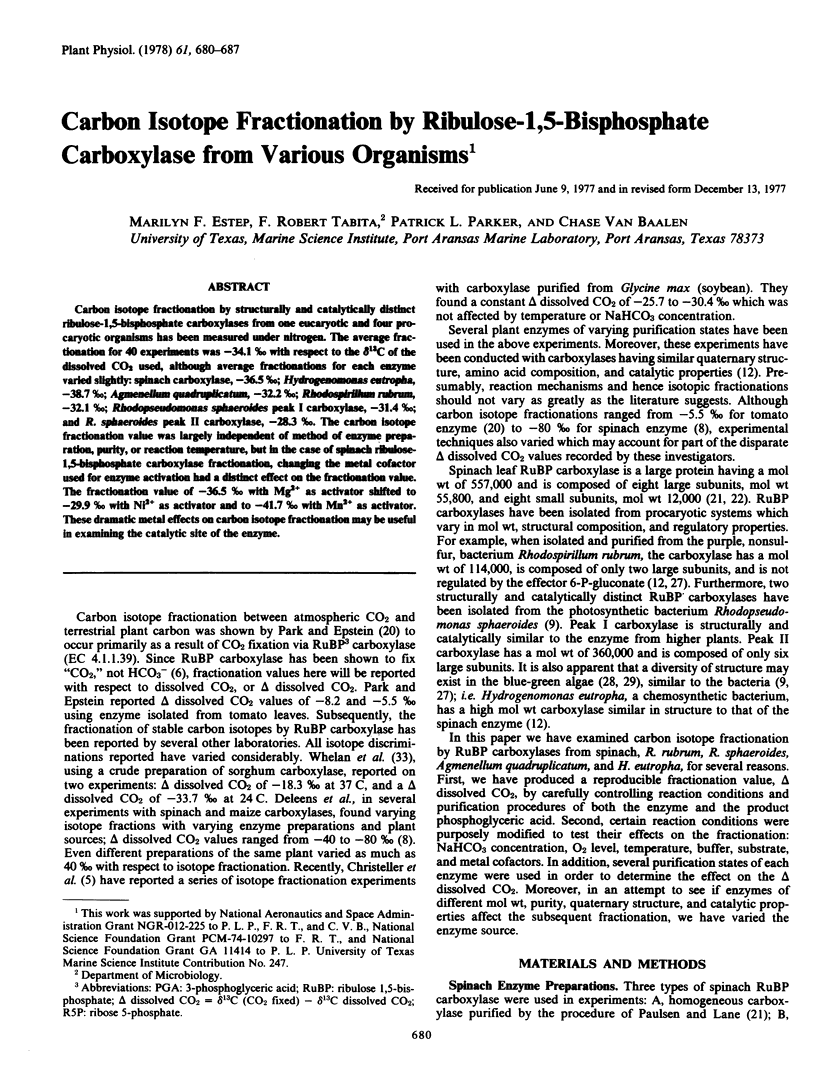
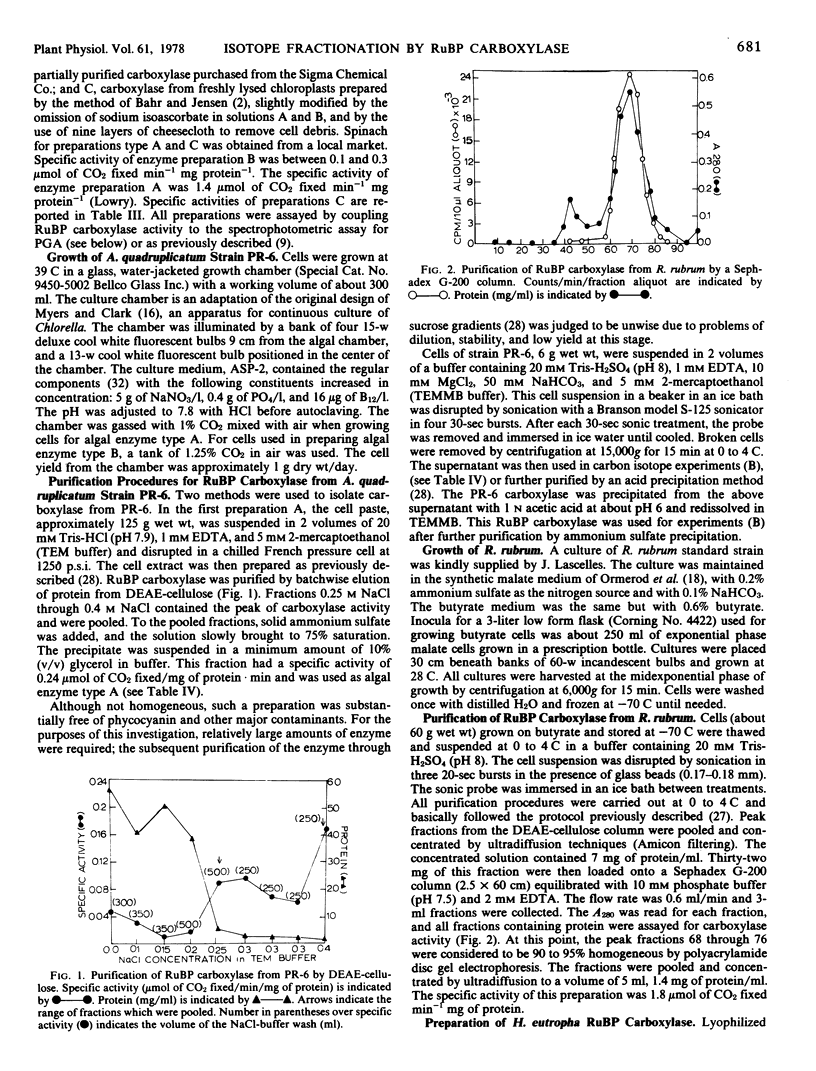
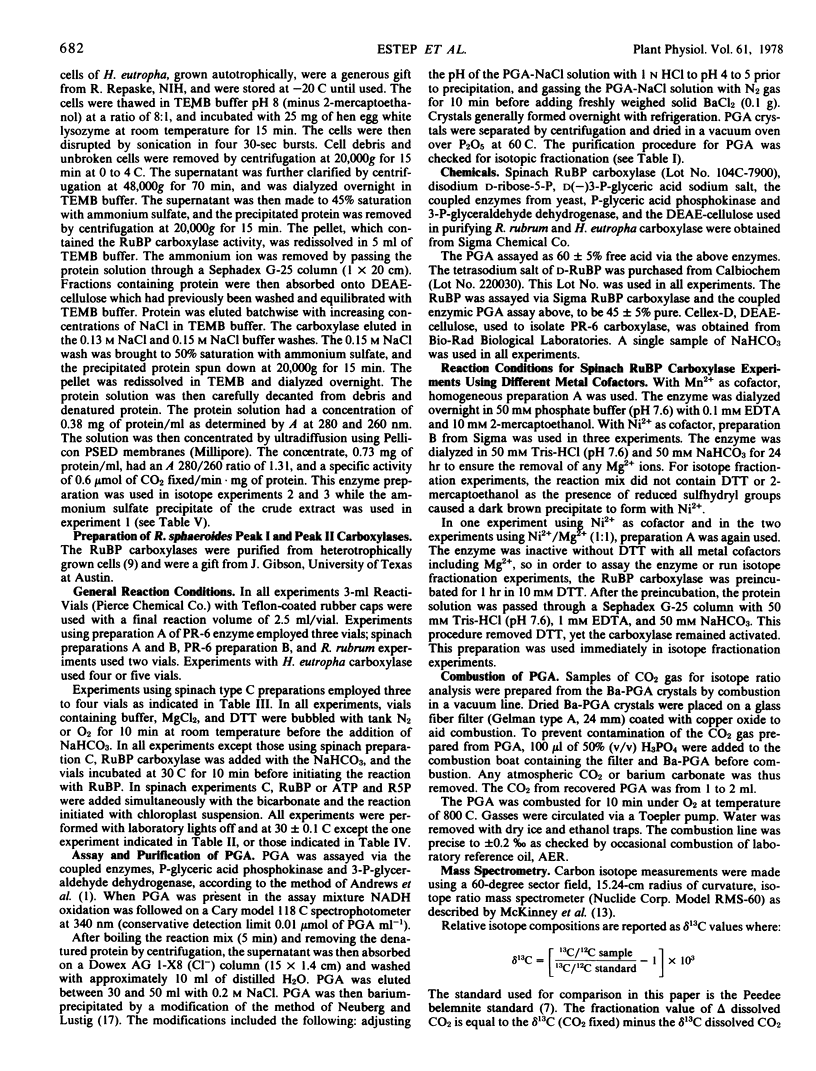
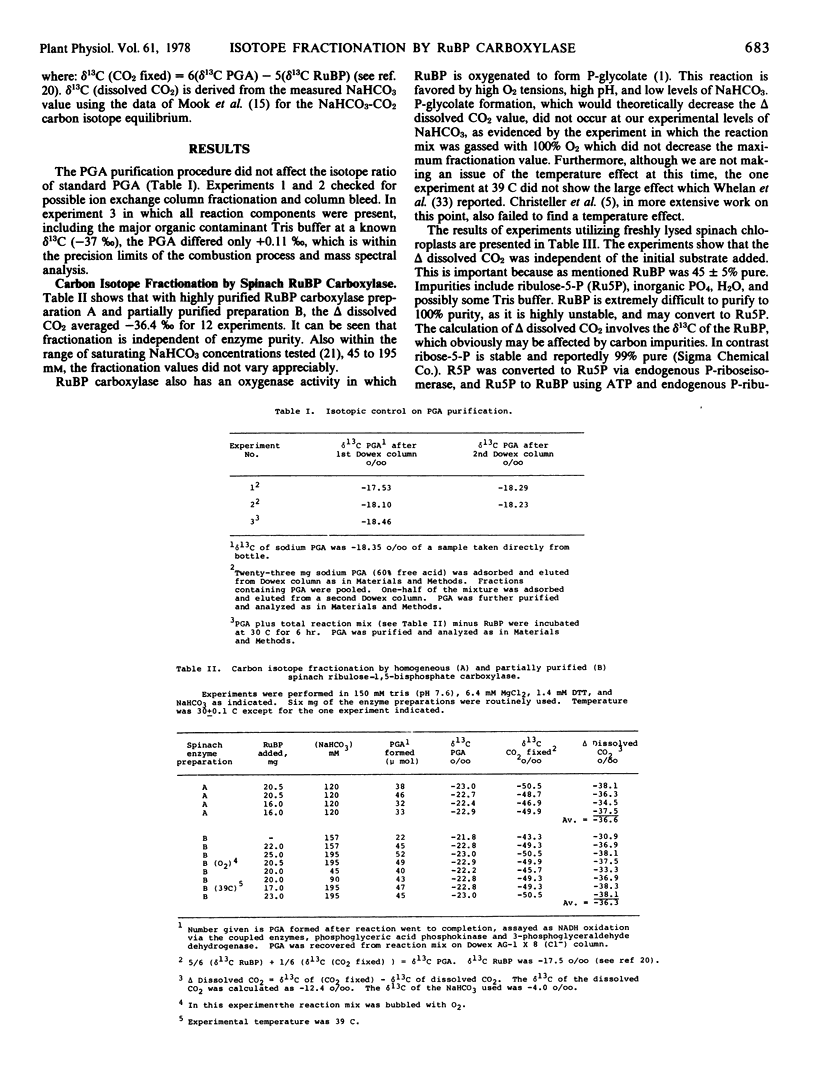
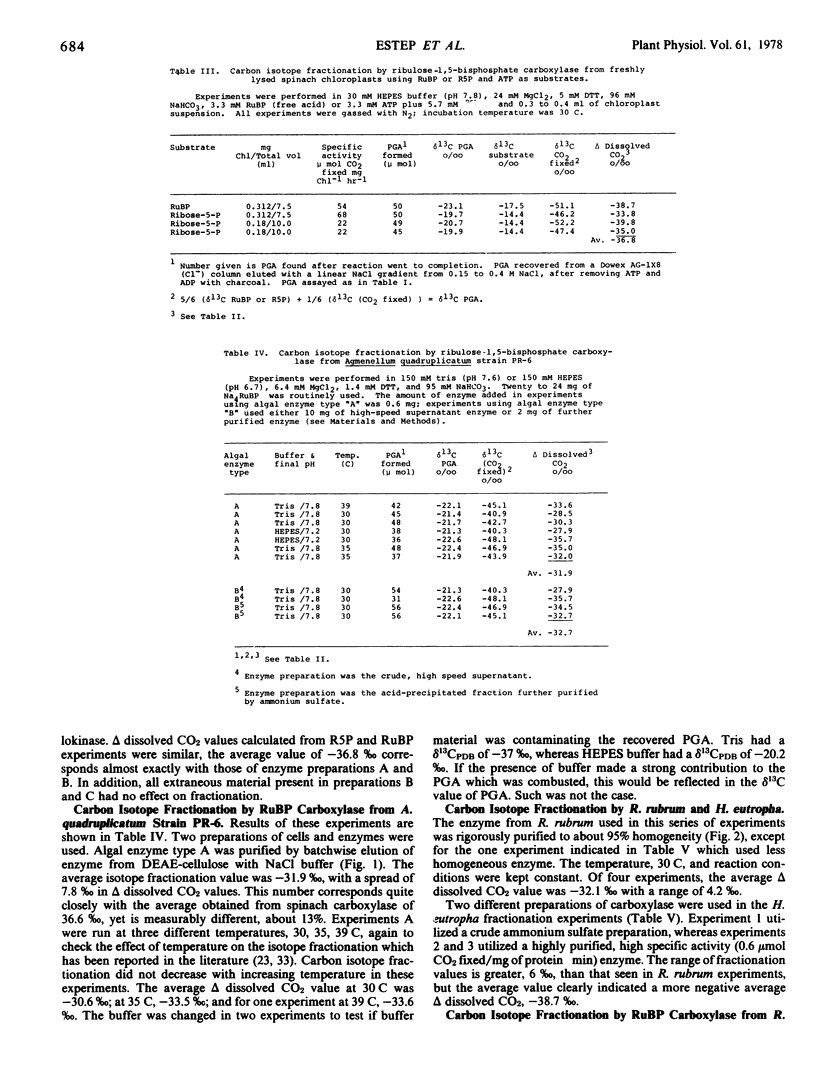
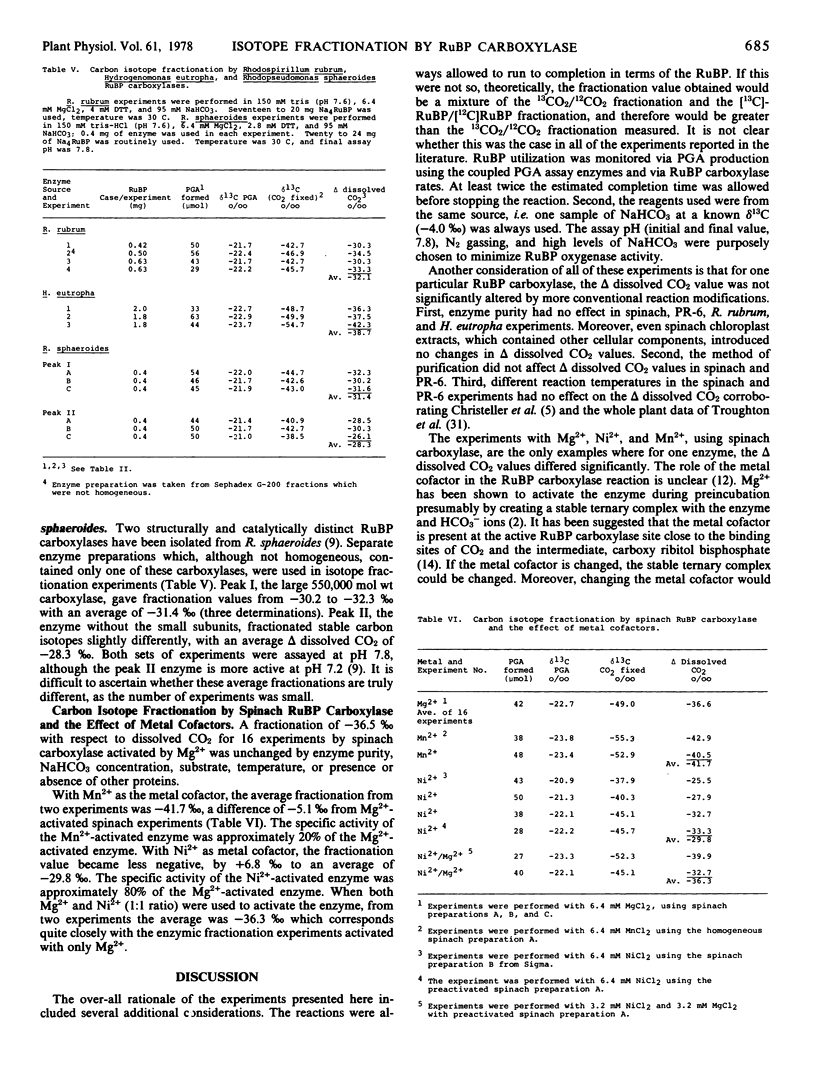
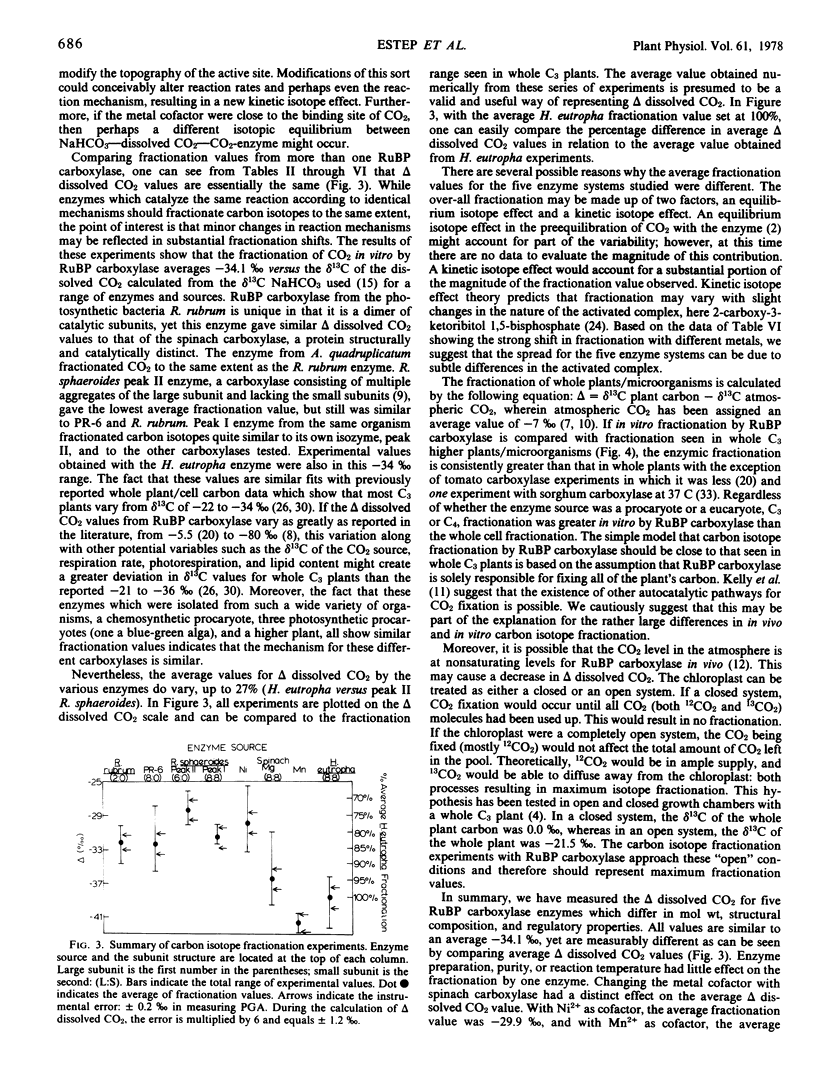

Selected References
These references are in PubMed. This may not be the complete list of references from this article.
- Andrews T. J., Lorimer G. H., Tolbert N. E. Ribulose diphosphate oxygenase. I. Synthesis of phosphoglycolate by fraction-1 protein of leaves. Biochemistry. 1973 Jan 2;12(1):11–18. doi: 10.1021/bi00725a003. [DOI] [PubMed] [Google Scholar]
- Bahr J. T., Jensen R. G. Ribulose Diphosphate Carboxylase from Freshly Ruptured Spinach Chloroplasts Having an in Vivo Km[CO(2)]. Plant Physiol. 1974 Jan;53(1):39–44. doi: 10.1104/pp.53.1.39. [DOI] [PMC free article] [PubMed] [Google Scholar]
- Christeller J. T., Laing W. A. Isotope Discrimination by Ribulose 1,5-Diphosphate Carboxylase: No Effect of Temperature or HCO(3) Concentration. Plant Physiol. 1976 Apr;57(4):580–582. doi: 10.1104/pp.57.4.580. [DOI] [PMC free article] [PubMed] [Google Scholar]
- Cooper T. G., Filmer D. The active species of "CO2" utilized by ribulose diphosphate carboxylase. J Biol Chem. 1969 Feb 10;244(3):1081–1083. [PubMed] [Google Scholar]
- Gibson J. L., Tabita F. R. Different molecular forms of D-ribulose-1,5-bisphosphate carboxylase from Rhodopseudomonas sphaeroides. J Biol Chem. 1977 Feb 10;252(3):943–949. [PubMed] [Google Scholar]
- McFadden B. A., Tabita F. R. D-ribulose-1, 5-diphosphate carboxylase and the evolution of autotrophy. Biosystems. 1974 Oct;6(2):93–112. doi: 10.1016/0303-2647(74)90002-1. [DOI] [PubMed] [Google Scholar]
- McKINNEY C. R., McCREA J. M., EPSTEIN S., ALLEN H. A., UREY H. C. Improvements in mass spectrometers for the measurement of small differences in isotope abundance ratios. Rev Sci Instrum. 1950 Aug;21(8):724–730. doi: 10.1063/1.1745698. [DOI] [PubMed] [Google Scholar]
- Miziorko H. M., Mildvan A. S. Electron paramagnetic resonance, 1-H, and 13C nuclear magnetic resonance studies of the interaction of manganese and bicarbonate with ribulose 1, 5-diphosphate carboxylase. J Biol Chem. 1974 May 10;249(9):2743–2750. [PubMed] [Google Scholar]
- ORMEROD J. G., ORMEROD K. S., GEST H. Light-dependent utilization of organic compounds and photoproduction of molecular hydrogen by photosynthetic bacteria; relationships with nitrogen metabolism. Arch Biochem Biophys. 1961 Sep;94:449–463. doi: 10.1016/0003-9861(61)90073-x. [DOI] [PubMed] [Google Scholar]
- Paulsen J. M., Lane M. D. Spinach ribulose diphosphate carboxylase. I. Purification and properties of the enzyme. Biochemistry. 1966 Jul;5(7):2350–2357. doi: 10.1021/bi00871a025. [DOI] [PubMed] [Google Scholar]
- Rutner A. C. Estimation of the molecular weight of ribulose diphosphate carboxylase sub-units. Biochem Biophys Res Commun. 1970 Jun 5;39(5):923–929. doi: 10.1016/0006-291x(70)90412-2. [DOI] [PubMed] [Google Scholar]
- Sackett W. M., Eckelmann W. R., Bender M. L., Bé A. W. Temperature Dependence of Carbon Isotope Composition in Marine Plankton and Sediments. Science. 1965 Apr 9;148(3667):235–237. doi: 10.1126/science.148.3667.235. [DOI] [PubMed] [Google Scholar]
- Siegel M. I., Lane M. D. Chemical and enzymatic evidence for the participation of a 2-carboxy-3-ketoribitol-1,5-diphosphate intermediate in the carboxylation of ribulose 1,5-diphosphate. J Biol Chem. 1973 Aug 10;248(15):5486–5498. [PubMed] [Google Scholar]
- Sirevåg R., Buchanan B. B., Berry J. A., Troughton J. H. Mechanisms of CO2 fixation in bacterial photosynthesis studied by the carbon isotope fractionation technique. Arch Microbiol. 1977 Feb 4;112(1):35–38. doi: 10.1007/BF00446651. [DOI] [PubMed] [Google Scholar]
- Smith B. N., Epstein S. Two categories of c/c ratios for higher plants. Plant Physiol. 1971 Mar;47(3):380–384. doi: 10.1104/pp.47.3.380. [DOI] [PMC free article] [PubMed] [Google Scholar]
- Tabita F. R., McFadden B. A. D-ribulose 1,5-diphosphate carboxylase from Rhodospirillum rubrum. II. Quaternary structure, composition, catalytic, and immunological properties. J Biol Chem. 1974 Jun 10;249(11):3459–3464. [PubMed] [Google Scholar]
- Tabita F. R., Stevens S. E., Jr, Gibson J. L. Carbon dioxide assimilation in blue-green algae: initial studies on the structure of ribulose 1,5-bisphosphate carboxylase. J Bacteriol. 1976 Feb;125(2):531–539. doi: 10.1128/jb.125.2.531-539.1976. [DOI] [PMC free article] [PubMed] [Google Scholar]
- Takabe T., Nishimura M., Akazawa T. Presence of two subunit types in ribulose-1,5-bisphosphate carboxylase from blue-green algae. Biochem Biophys Res Commun. 1976 Jan 26;68(2):537–544. doi: 10.1016/0006-291x(76)91179-7. [DOI] [PubMed] [Google Scholar]
- Whelan T., Sackett W. M. Enzymatic fractionation of carbon isotopes by phosphoenolpyruvate carboxylase from c(4) plants. Plant Physiol. 1973 Jun;51(6):1051–1054. doi: 10.1104/pp.51.6.1051. [DOI] [PMC free article] [PubMed] [Google Scholar]


